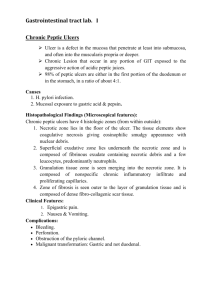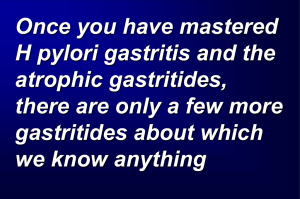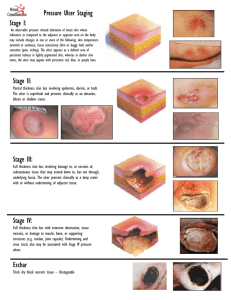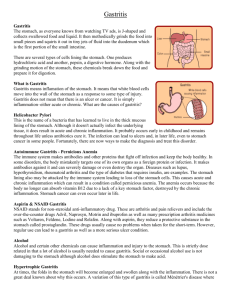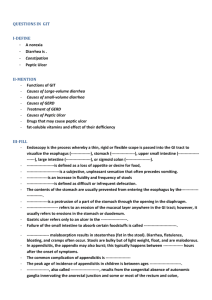1 Diseases of Stomach and Intestine Gastritis •is the inflammation of
advertisement
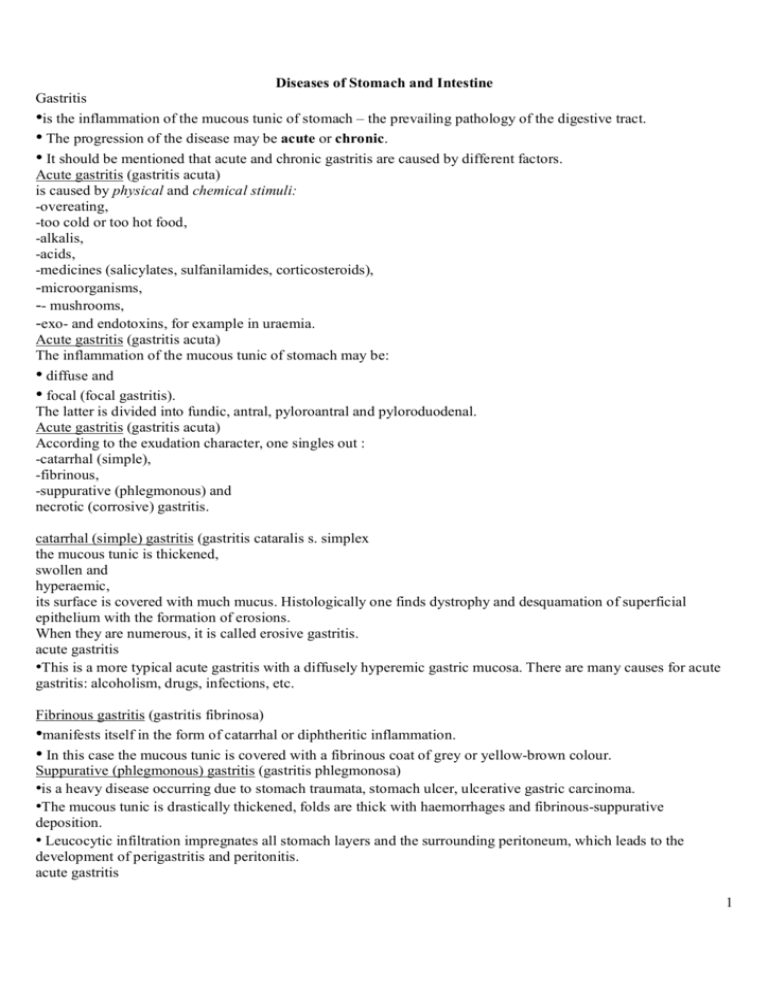
Diseases of Stomach and Intestine Gastritis •is the inflammation of the mucous tunic of stomach – the prevailing pathology of the digestive tract. • The progression of the disease may be acute or chronic. • It should be mentioned that acute and chronic gastritis are caused by different factors. Acute gastritis (gastritis acuta) is caused by physical and chemical stimuli: -overeating, -too cold or too hot food, -alkalis, -acids, -medicines (salicylates, sulfanilamides, corticosteroids), -microorganisms, -- mushrooms, -exo- and endotoxins, for example in uraemia. Acute gastritis (gastritis acuta) The inflammation of the mucous tunic of stomach may be: • diffuse and • focal (focal gastritis). The latter is divided into fundic, antral, pyloroantral and pyloroduodenal. Acute gastritis (gastritis acuta) According to the exudation character, one singles out : -catarrhal (simple), -fibrinous, -suppurative (phlegmonous) and necrotic (corrosive) gastritis. catarrhal (simple) gastritis (gastritis cataralis s. simplex the mucous tunic is thickened, swollen and hyperaemic, its surface is covered with much mucus. Histologically one finds dystrophy and desquamation of superficial epithelium with the formation of erosions. When they are numerous, it is called erosive gastritis. acute gastritis •This is a more typical acute gastritis with a diffusely hyperemic gastric mucosa. There are many causes for acute gastritis: alcoholism, drugs, infections, etc. Fibrinous gastritis (gastritis fibrinosa) •manifests itself in the form of catarrhal or diphtheritic inflammation. • In this case the mucous tunic is covered with a fibrinous coat of grey or yellow-brown colour. Suppurative (phlegmonous) gastritis (gastritis phlegmonosa) •is a heavy disease occurring due to stomach traumata, stomach ulcer, ulcerative gastric carcinoma. •The mucous tunic is drastically thickened, folds are thick with haemorrhages and fibrinous-suppurative deposition. • Leucocytic infiltration impregnates all stomach layers and the surrounding peritoneum, which leads to the development of perigastritis and peritonitis. acute gastritis 1 •At high power, gastric mucosa demonstrates infiltration by neutrophils. Necrotic (corrosive) gastritis (gastritis necrotica s. corrosiva) •is the result of acids’ and alkalis’ influence on the mucous tunic of stomach, when they coagulate and destroy it. •The necrotic process may lead to the development of phlegmon and even perforation. Consequence of gastritis •Catarrhal gastritis treated in time ends with recovery • but it may sometimes be recurrent and develop into the chronic form. •Necrotic and phlegmonous gastritis ends with sclerotic deformation of the organ – gastric cirrhosis. Chronic gastritis (gastritis chronica) •is a separate disease with its own aetiology and pathogenesis, rarely connected with acute gastritis. •is characterized by long-lasting dystrophic and •necrobiotic changes of mucous tunic epithelium in combination with • regeneration disorder and structural change of the mucous tunic. •The process ends with atrophy and •sclerosis. • Chronic gastritis (gastritis chronica •Important to the aetiology : •exogenous factors – eating pattern disorder, •alcohol abuse, • the effect of thermal, •chemical and mechanical stimuli. •Among the endogenous factors the greatest attention is paid to autoinfection, in particular Helicobacter pylori, •to chronic autointoxication, • endocrine and cardiovascular diseases, •allergic reactions and •duodenogastric reflux. Chronic gastritis (gastritis chronica •Regeneration disorders mainly consist in the slowing-down of parietal cells differentiation. •There appear immature cells that perish very soon, before the differentiation is completed. •So, chronic gastritis is not an inflammatory process but a manifestation of regeneration disorder and dystrophy. Chronic gastritis (gastritis chronica According to the topography, chronic gastritis is divided into: • fundic, •antral and •pangastritis. According to the aetiology and the pathogenesis, one distinguishes : -gastritis A, -gastritis B and -gastritis C. Chronic gastritis (gastritis chronica The prevailing one is gastritis B – nonimmune gastritis. It is caused by Helicobacter pylori, intoxications, alcohol abuse and malnutrition. According to Houston classification one singles out 3 types of chronic gastritis: nonatrophic, atrophic and 2 specific forms. Gastritis A is autoimmune gastritis caused by the appearance of antibodies to parietal cells and characterized by the lesion of the fundic part. It often goes together with other autoimmune diseases and is accompanied by the decrease of hydrochloric acid secretion and the development of pernicious anaemia.. Gastritis C •is reflux gastritis caused by duodenogastric reflux and • characterized by the lesion of the antral part. •It often occurs after stomach resection Chronic atrophic gastritis •is characterized by a qualitatively new peculiarity – glands atrophy that precedes the development of sclerosis. •From the endoscopic point of view, stomach cushions are either smoothed or look like villi and resemble polyps. •They are covered with epitheliocytes with edging and goblet cells (intestinal metaplasia of epithelium). •Glands atrophy and mucoid degeneration of epithelium cause the disorder of pepsin and hydrochloric acid secretion. It manifests itself clinically in the increased gastrin level in blood and decreased acidity of gastric juice. This gastritis is connected with autoimmune processes, pernicious anaemia and gastric carcinoma. It occurs in patients’ close relatives, in combination with thyroiditis and diffuse toxic goiter. nonatrophic chronic gastritis •there is no gastrinaemia, • the hydrochloric acid secretion is in the normal range, slightly decreased or increased. This gastritis is connected with Helicobacter pylori and the development of peptic ulcer. •Among specific gastritis forms reflux gastritis is the most frequent. Chronic gastritis Morphologically one distinguishes between superficial and atrophic gastritis. •Superficial gastritis is characterized by deranged regeneration and dystrophy of superficial epithelium. In some mucous tunic areas it becomes similar to the cuboidal one characterized by hyposecretion. •In other areas the epithelium resembles in its form the high prismatic one and has hypersecretion. •Later the dystrophic changes affect glands. • The mucous tunic proper layer gets densely infiltrated with lymphocytes, plasmocytes and solitary neutrophils. Menetrier’s disease (giant hypertrophic gastritis is a specific chronic gastritis form in which the mucous tunic is greatly thickened and looks like convolutions of the brain. The morphologic basis of the disease is the proliferation of glandular epithelium cells, hyperplasia of glands, the infiltration of mucous tunic with lymphocytes, plasmocytes, epithelioid and giant cells, and the formation of cysts. •With most evident processes of deranged regeneration and structural formation which lead to cellular atypia (dysplasia), chronic gastritis is often the basis for the development of gastric carcinoma. Peptic ulcer •is a general chronic recurrent disease that affects stomach or duodenum. •The ulcer has a polycyclic progression and is characterized by seasonal exacerbations. gastric ulcers of small, medium, and large size on upper endoscopy Aetiology of Peptic ulcer •According to the contemporary view, the main role in the disease’s aetiology is played by psycho-emotional and physical overstress. •Under stress conditions the system ‘hypothalamus – adenohypophysis – adrenal gland cortex’ gets activated and glucocorticoid production eventually increases. •This hormone stimulates gastric secretion and increases the acidity of gastric contents. At the same time it decreases mucus secretion, hinders protein synthesis and cell reproduction in the mucous tunic of stomach. The 3 ulcerogenic action of glucocorticoids also makes itself felt in cases when they are introduced for medicinal purposes. stress ulcers •because they can appear in patients with a variety of stressful conditions, including trauma, burns, sepsis, and shock. Anti-inflammatory drugs such as aspirin and non-steroidal anti-inflammatory drugs may play a role in their appearance. Aetiology of Peptic ulcer •Important are also direct damaging influences on the stomach – constant eating of too hot, • too coarse or too spicy food, • eating pattern disorder, •alcohol abuse and smoking. • In recent years a significant role has been allotted to Helicobacter pylori that destroys the mucous barrier of the stomach and makes its mucous tunic vulnerable to the digestive action of gastric juices. Aetiology of Peptic ulcer •The aetiologic role of the hereditary factor is also proved. •Peptic ulcer is associated with blood group 0 (I) and the presence of Rh-antigen. •It is the prevailing tonus of the parasympathetic part of the vegetative nervous system over the sympathetic part that lies in the basis of hereditary susceptibility. •The vagotonia stimulates gastric secretion and creates favourable conditions for the development of ulcer. morphogenesis of chronic recurrent gastric or duodenal ulcer the following stages: •erosion, •acute ulcer and •chronic ulcer. Erosion (erosio) is a superficial defect of mucous tunic that does not go deeper than its muscle plate. Such defects are usually acute and very rarely chronic. They occur as a result of necrosis of a mucous tunic area with subsequent haemorrhage and rejection of the mortified tissue. At the bottom of such defects one finds muriatic haematin of black colour and at its edges – a leucocytic infiltration. multiple Erosion acute peptic ulcer (ulcus acutum pepticum) •In the course of ulcer development, erosions, especially on the lesser curvature of stomach, do not close up. • Under the influence of gastric juices the layers of the stomach wall necrotize deeper and deeper and the erosion develops into an acute peptic ulcer (ulcus acutum pepticum) of round or oval form. •The lesser curvature is known to be a ‘food pathway’, so it is easily traumatized. Its glands secrete a very active digestive juice. The lesser curvature is rich in receptors and extremely reactive but its folds are rigid, and at the contraction of the muscular layer they cannot cover the defect. This causes bad closing up of lesser curvature injuries and the development of the acute ulcer into a chronic one (ulcus chronicum). That’s why chronic ulcers are usually located on the lesser curvature, in the antral and pyloric part. Ulcers in the cardial part and on the greater curvature of stomach are rare. acute peptic ulcer acute peptic ulcer acute peptic ulcer •Microscopically, the ulcer here is sharply demarcated, with normal gastric mucosa on the left falling away into a deep ulcer whose base contains infamed, necrotic debris. An arterial branch at the ulcer base is eroded and bleeding. 4 Multiple peptic ulcer Chronic ulcer •may penetrate into the serous tunic. •Its edges look like cushions, they are dense, sometimes callous (callous ulcer), its bottom is smooth or rough. •The edge of ulcer, turned to the oesophagus, is undermined and the mucous tunic hangs over the defect. There forms a pocket in which gastric contents accumulate. •The edge of ulcer, turned to the hilus, is sloping. Chronic ulcer Microscopically the bottom of such ulcer is represented by: connective tissue, • and in the mucous tunic one finds chronic inflammation at the edges of the defect. Chronic ulcer The indications of exacerbation of peptic ulcer are the appearance: of fibrinoid necrosis isolated with a leucocytic layer and granulation tissue, and fibrinoid changes of vessel walls at the bottom of ulcer. At closing up, one can observe at the bottom of ulcer connective tissue with obliterated vessels, the epithelization of mucous tunic defect. duodenal ulcer •The morphogenesis of duodenal ulcer is identical. According to the localization, one distinguishes between: • bulbar ulcer (on the front or the back wall of the bulb), • postbulbar (below the bulb) and • “kissing” ulcers (located opposite each other on the front and the back wall of the bulb). duodenal ulcer complications of peptic ulcer are divided, according to V.Samsonov, into the following groups: ulcerative-destructive – haemorrhage, perforation, penetration (into pancreas, large intestine wall, liver, etc.); inflammatory – gastritis, duodenitis, perigastritis, periduodenitis; ulcerocicatricial – narrowing of the upper and the lower (outlet) part of stomach, deformation of stomach, narrowing of the duodenal lumen, deformation of the duodenal bulb; ulcer malignization – the development of cancer; combined complications. Haemorrhages •occur in the period of exacerbation due to fibrinoid necrosis of vessel walls (arrosive haemorrhage). •An affected person vomits with “coffee grounds”, the colour is determined by muriatic haematin. • Fecal masses get the colour and the consistency of tar. Such fecal masses are called melaena. arrosive haemorrhage Perforation (perforatio) •usually occurs with ulcers on the front wall of the duodenal bulb. •The inrush goes into the abdominal cavity, the retroperitoneal space and the lesser omentum. • Perforation occurs in the period of exacerbation and leads to diffuse peritonitis – suppurative-fibrinous inflammation of peritoneum. A complication of ulceration 5 •is perforation seen here in the first portion of the duodenum just beyond the pylorus. As consequence, there is an acute peritonitis with exudate seen over peritoneal surfaces. An abdominal radiograph would demonstrate free air. Penetration (penetratio) •is spreading of ulcer beyond stomach or duodenum when other organs’ tissues become the bottom of ulcer – pancreas, lesser omentum, transverse colon, gallbladder, liver. •Penetration causes digestion by gastric juices of the neighbouring organ’s tissue and inflammation of the organ. penetrate of the Ulcer •Penetration leads to pain. If the ulcer penetrates through the muscularis and through adventitia, then the ulcer is said to "perforate" and leads to an acute abdomen. An abdominal radiograph may demonstrate free air with a perforation. Inflammatory complications •lead to the formation of commissures. Occasionally ulcer may be complicated by phlegmon. closing up ulcer leaves a thick scar that often causes pyloric stenosis. •Food masses are retained in the stomach, an affected person often vomits. •This causes loss of water, salts and hydrochloric acid, and the development of chlorohydropenic uraemia (gastric tetany). Stomach Cancer (Gastric Carcinoma) •More often it occurs in men older than 50. •Among the aetiologic factors are endogenous nitrosoamines, exogenous nitrates, Helicobacter pylori. •The precancerous conditions are: • adenomatous polyp, •chronic atrophic gastritis, •chronic stomach ulcer, •gastric stump, •pernicious anaemia, • heavy epithelial dysplasia of the mucous tunic of stomach. •According to the localization, gastric carcinoma usually occurs in the pyloric part and on the lesser curvature. Stomach Cancer (Gastric Carcinoma) •According to the character of growth, one singles out the following clinicoanatomic (macroscopic) forms of gastric carcinoma: exophytic expansive growth (plaque-forming, polypous, fungous, ulcerative); endophytic infiltrating growth; exoendophytic growth. • One singles out early gastric carcinoma that grows not deeper than the submucous layer. Stomach Cancer (Gastric Carcinoma) According to the histologic structure, one distinguishes between: • adenocarcinoma, •undifferentiated carcinoma, •squamous cell carcinoma, •squamous cell adenocarcinoma, • unclassified carcinoma. gastric adenocarcinoma •A moderately differentiated gastric adenocarcinoma is infiltrating up and into the submucosa below the squamous mucosa of the esophagus. The neoplastic glands are variably sized. gastric adenocarcinoma 6 •At higher magnification, the neoplastic glands of gastric adenocarcinoma demonstrate mitoses, increased nuclear/cytoplasmic ratios, and hyperchromatism. There is a desmoplastic stromal reaction to the infiltrating glands. gastric adenocarcinoma •At high power, this gastric adenocarcinoma is so poorly differentiated that glands are not visible. Instead, rows of infiltrating neoplastic cells with marked pleomorphism are seen. Many of the neoplastic cells have clear vacuoles of mucin. adenocarcinoma •This is a signet ring cell pattern of adenocarcinoma in which the neoplastic cells are filled with cytoplasmic mucin vacuoles that compress the nucleus to one side, as shown at the arrow. Signet ring cell adenocarcinomas are poorly differentiated and tend to be highly invasive. Metastasis of gastric carcinoma: lymphogenic : •(lymph nodes along the greater and the lesser curvature of stomach, •Virkhov’s metastasis – left supraclavicular lymph nodes, •Krukenberg’s tumour – both ovaries, • Schnitzler’s metastasis – pelvic (perirectal) fat tissue), •hematogenic and • implantation metastasis. Metastasis of gastric carcinoma adenocarcinoma in the ampulla of Vater •Primary small intestinal carcinomas are very rare, but the majority of those that do occur arise in the region of the ampulla, where they may become symptomatic through biliary or pancreatic duct obstruction. The appearance of such a mass on esophagogastroduodenoscopy is seen below, and following placement of a stent for drainage. leiomyosarcoma of the small bowel •As with sarcomas in general, this one is big and bad. Sarcomas are uncommon at this site, but must be distinguished from other types of neoplasms Appendicitis is an acute or chronic inflammation of appendix with characteristic clinical symptoms. •Aetiology: • an activated enterogenous autoinfection. •Vascular disorders of neurogenic nature in the appendix wall are considered to be the starting mechanism for the disease development. •Vasospasm leads to blood and lymph stasis, haemorrhages, the organ’s trophism derangement, the development of dystrophic and necrobiotic changes of its tissues. • This ensures infectious organisms’ invasion and the development of suppurative inflammation. Favourable for the appendicitis development is deranged peristalsis, atony and kinking of appendix, formation of fecal boluses in the lumen, presence of parasites and foreign bodies. normal appendix •This is the normal appearance of the appendix against the background of the cecum Acute appendicitis in its turn, has three morphologic forms that may be regarded as consecutive stages of the inflammatory process: -simple, -superficial and -destructive (phlegmonous, apostematous, ulcerophlegmonous, gangrenous). simple appendicitis. 7 •In the first hours after the attack of the disease there develops simple appendicitis. •It is characterized by blood and lymph circulation disorders, • namely – stasis, • edema, •haemorrhages, •marginal elevation of leucocytes, •leucodiapedesis. Superficial appendicitis •The appendix grows thick and the serous tunic becomes plethoric and dingy. Superficial appendicitis manifests itself morphologically in primary affect. • This term denotes a focus of suppurative inflammation with mucous tunic erosion on the basis of circulation disorders acute appendicitis •with yellow to tan exudate and hyperemia, including the periappendiceal fat superiorly, rather than a smooth, glistening pale tan serosal surface. acute appendicitis •Microscopically, acute appendicitis is marked by mucosal inflammation and necrosis. destructive appendicitis •From the primary affect, localized usually in the distal part of the appendix, the suppurative inflammation spreads over the whole organ – there develops phlegmonous appendicitis. •The appendix is thick, its serous tunic is dingy and covered with fibrinous exudation. From the lumen there comes pus. • The mesentery is swollen and hyperaemic. destructive appendicitis •If the suppurative process is limited around the primary affect with the formation of small abscesses, it is called apostematous appendicitis. •On the basis of phlegmonous inflammation there often occur mucous tunic ulcers. It is typical of ulcerophlegmonous appendicitis. destructive appendicitis •Diffuse suppurative inflammation does not limit itself to appendix but spreads to the surrounding tissues and mesentery with the development of periappendicitis and mesenteritis. •At mesentery lesion there often occurs appendicular artery thrombosis which causes gangrene of the appendix. That is how secondary gangrenous appendicitis appears. It is called secondary because the thrombosis is the result of the previous suppurative inflammation of the appendix. That is the difference between it and appendix gangrene (primary gangrenous appendicitis) that develops on the basis of primary thrombosis or thromboembolism of its artery. Complications of Acute appendicitis are connected with the destruction of appendix wall and the spreading of the suppurative inflammation to the surrounding tissues. •In ulcerophlegmonous appendicitis there often occurs perforation with subsequent development of peritonitis. •In cases of lumen blockage in the proximal part of the appendix pus accumulates in the distal part. The organ resembles a sack with pus (appendix empyema). Complications of Acute appendicitis •The spreading of inflammation to the surrounding tissues is called periappendicitis, 8 •to the blind gut – perityphlitis, •to the mesentery – mesenteritis. The latter may end with suppurative thrombophlebitis of mesentery vessels. •Further spreading of the process leads to the inflammation of liver veins (pylephlebitis), thromboembolism of portal vein branching and the formation of pylephlebitic abscesses in the liver. Chronic appendicitis •develops after endured acute one and • is characterized by atrophic and sclerotic changes. •In cases of self-recovery acute inflammation ends with the development of granulation tissue in the zone of primary affect. There have been cases when the appendix lumen was completely filled with granulation and fibrous tissue (obliteration of appendix). Chronic appendicitis •Sometimes scar tissue obliterates only the proximal part and in the distal one serous fluid accumulates. The appendix turns into a cyst (hydrocele). •If glands intensely produce mucus, it fills the cyst contents (mucocele). •Very rarely the mucus turns into mucous globules (myxoglobulosis). •Occasionally, due to cyst rupture, the mucus flows out into the abdominal cavity and the mucus-producing cells settle down and become the source of pseudomyxoma peritonei. Chronic colitis •At higher magnification, the overlying pseudomembrane at the left has numerous inflammatory cells, mainly neutrophils. Regional Enteritis (Crohn’s Disease) Regional enteritis is a chronic inflammatory lesion of intestinal wall, usually of the terminal part of ileum, though it may affect all parts of the digestive tract. •There develops a nonspecific granulomatous inflammation without necrosis (it resembles sarcoidosis) and with submucous tunic fibrosis and narrowing of the intestinal lumen. •Typical of the disease is the alteration of affected and unaffected areas. •In the mucous tunic one finds deep transverse and longitudinal ulcers, edema of the submucous tunic. • Macroscopically the mucous tunic resembles a cobblestone pavement. • Among the complications are diarrhoea, malabsorption syndrome, intestinal obstruction, fistulas and degeneration into cancer. Gangrena of the bowel small adenomatous polyp (tubular adenoma) •acute appendicitis •disorganized glands than the normal underlying colonic mucosa. Goblet cells are less numerous and the cells lining the glands of the polyp have hyperchromatic nuclei small adenomatous polyp (tubular adenoma) •Two colonoscopic views of a small polyp that proved to be a tubular adenoma is seen below. adenocarcinoma of the small bowel Non-Hodgkin's lymphomas of the bowel •do occur uncommonly. The multifocal irregular tan-to-brown masses seen here on the mucosal surface are in a patient with AIDS. Lymphomas in AIDS are high-grade. non-Hodgkin's lymphoma cells •The large blue non-Hodgkin's lymphoma cells can be seen infiltrating through the mucosa. thanks 9

